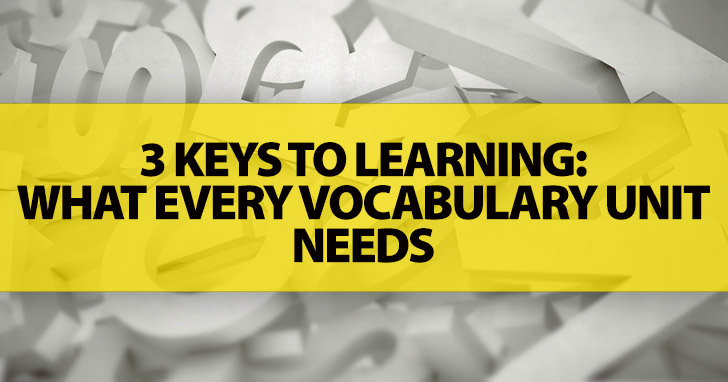4 Fresh Ways to Introduce New Vocabulary


You want students to learn, recognize and produce the words naturally in English. Helping your students accomplish this goal is really quite simple, even when the words on the list are complex. As long as your vocabulary unit contains these three key activities, your students will be well on their way to using these words fluently.
If you are following a curriculum that designates vocabulary for your students, choosing your vocabulary words is very easy. If you are developing your own vocabulary lists or if you want to add to what the curriculum has already put together, you have a little more work to do. You may choose your words based on a listening or reading passage you will cover with your students. You may develop a vocabulary web or present vocabulary clusters (synonyms or antonyms) to your students. You can choose appropriate vocabulary for your class a lot of different ways, and once you do you are ready to move on to the first key component of any vocabulary unit.
Once you have your list of vocabulary words, it is time to introduce them to your students. Before you hand out a list of words and their corresponding definitions though, it’s best to have students try to decipher the meanings of the words from context. For some students this exercise will be very uncomfortable. Bilingual dictionaries will come out faster than a cowboy can draw a pistol, but you’ll have to stand firm with a no dictionary rule. Make sure your students know that you do not expect right answers at this stage in the vocabulary learning process but that you want to challenge their ability to understand unfamiliar words without external aids. Start by giving them a sentence using each target vocabulary word. If possible, take the sentence from the text you are using or from the dialogue you will present to your students. Have students use prior knowledge and context clues to guess at and note the definition of the word. Once your students have guessed each word’s meaning from its context, give them a list of definitions and challenge them to match each word to its correct definition and modify their own definitions as necessary. Students who develop this skill, determining a definition from a word’s context, will find future encounters with unfamiliar vocabulary less intimidating and off putting. In fact, determining meaning from context is a skill that even native speakers must learn.

Now that your students have some familiarity with their vocabulary words, it’s time to weave them into your students’ speech and writing. To start, give your students recognition tasks. Recognition tasks are those that provide your students with the target vocabulary and ask them to use the words appropriately. Here are two examples of recognition tasks.
Index cards are one of my favorite tools for the ESL classroom, and they are especially useful for recognition tasks in vocabulary development. Have students write each target vocabulary word on one card and a definition, synonym, or picture of the word on another card. Shuffle the cards and have students match each word to its definition. You can lay the cards out so your students can see them all at once, play a memory style game, play go fish matching words and definitions, or do any other activity where the ultimate goal is to match each word with its definition.
Another way to challenge your students’ word recognition skills is to have them complete a fill in the blank with the target vocabulary words. Give them a list of sentences or a paragraph using the target words along with a word bank. Like any fill in the blank exercise, students must use the clues in each sentence to determine which word best fits the context. Though it might be tempting, don’t omit the word bank. At this point in the learning process, your students are just determining how the target words are used and not coming up with them on their own.

The final step in the vocabulary learning process is to give your students production tasks. In these tasks, they are starting with just the word (not its definition or context) and then determining on their own how to use it appropriately. Here are three examples of recognition tasks.
You might challenge your students to use the target vocabulary in an oral exercise. Have groups of students compose a skit which uses the target words. Another option is to get out your index cards again and use them for a dialogue. Give two students a scenario for the role play and have them draw a vocabulary card. Each student must use his or her word appropriately in the dialogue before he can draw another card, and he must then use that word in the dialogue. Once all the cards are taken and used, the person with the most cards wins the role play challenge.
Have your students write their own sentences or a paragraph which uses the target vocabulary, again without bilingual dictionaries. Have them develop a crossword puzzle using their own definitions. Any situation in which students write can be directed to use specific vocabulary. In these exercises, start with a list of the words but no definitions and have students use them in their compositions.
Once you have given your students written and oral production tasks, have some fun with a game of Pictionary or charades using the target vocabulary. Grab those handy index cards and divide your class into two teams. Each person takes turns acting out or illustrating the vocabulary words for his team thus demonstrating his understanding of the word.
The process of learning vocabulary words doesn’t have to be complicated. Students start by determining the meaning of each word. They follow by using that word appropriately when they have context clues or definitions. Finally, they use the word appropriately in speech and writing without referring to outside sources for help. If your students can do this, they will not only learn the words you have chosen for your vocabulary unit. They will also have a tool that will serve them well in their futures as English speakers.